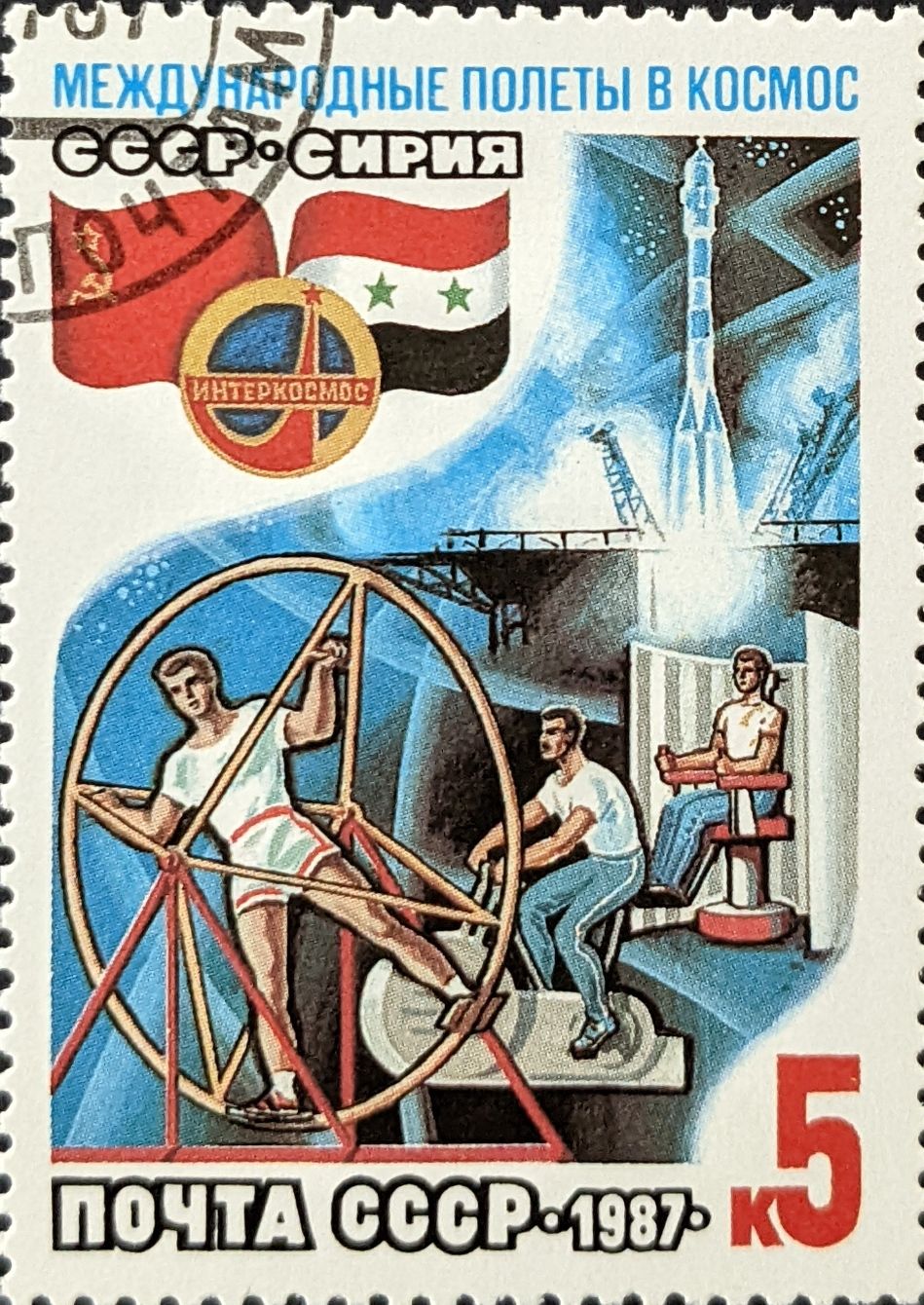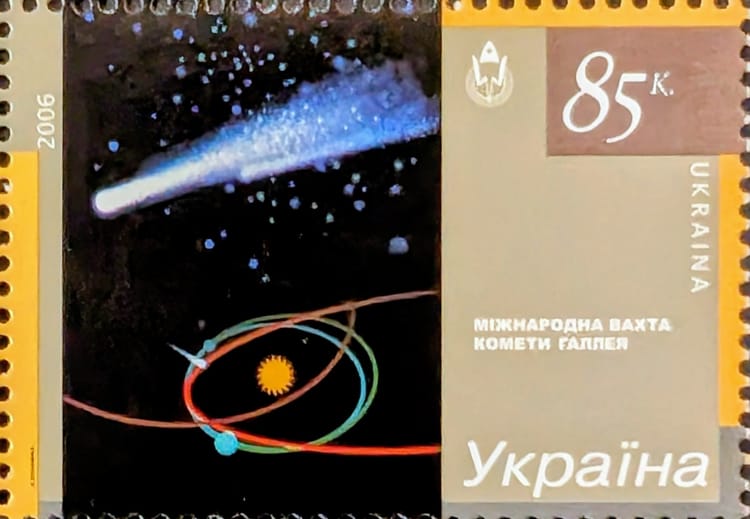Bluster II: the Breakup

It’s a little difficult to find Soyuz rocket stamps in my collection. But here’s one!
I will be taking a small break from writing next week, so there will be no post and email.
The thing about threats is they only work if the consequences from following up on them are meaningful—case in point, Dmitry Rogozin and Russia’s Roscosmos.
Broomsticks–Underrated Transportation?
The noise coming out from that nation’s space agency has made the news, primarily because Roscosmos’ leader, Dmitry Rogozin, appears to honestly believe that taking his space toys and going home will impact the global space industry. He even supplies great, if uninformed, quotes such as this one posted by Reuters:
"In a situation like this we can't supply the United States with our world's best rocket engines. Let them fly on something else, their broomsticks, I don't know what," Rogozin said on state Russian television.
Based on his previous quotes, we should expect no less–even if his information about U.S. broomstick technology (which is undoubtedly reusable) is inaccurate. However, he does go on these tears now and then, as he did a few years ago grousing about SpaceX’s success: “Bluster: Thoughts on Rogozin’s Response to SpaceX/NASA.” (I’m a little proud of the “photoshop” I did for the article header.) That he’s doing it now with “special sanctions” merely demonstrates his loyalty to his Putin bromance. He even has workers in Baikonur (which is in Kazakhstan) adding the “V” and “Z” markings (which were on Russian military vehicles in Ukraine) to the launch pad transporters to demonstrate unity with the Russian military.
Yes–what is theoretically a civilian-run agency for generally commercial purposes is applying military invasion markings on its equipment. Imagine the hullabaloo if NASA did something like that?
So, unsurprisingly, Rogozin is a Putin toad, but the bonus is he’s not merely that, he’s also worse than an ineffective leader–his actions, as he implements Putin’s agenda, are gutting the Russian space sector. The sector he was supposed to protect and improve is in one of its worst declines in its history. There may be a direct correlation between his actions against the industry as deputy prime minister and its current state, which isn’t healthy nor competitive. The bright side from this? He’s succeeded in implementing Putin’s bureaucratic solution to a commercial challenge, which will make for a great many case studies for those willing to learn.
Russian industry’s most successful rocket, the Soyuz, is also one of its most successful space exports. Unfortunately, it’s also ancient, and despite many, many announcements of new rocket programs during the last few decades, Russia still relies on Soyuz for most of its space activities. The Russian corporations producing rocket engines are in a similar dilemma, with the added factor that most nations are attempting to wean themselves off them. They eventually recognized the inherent security contradictions of relying on Russian technology to launch nationally necessary satellites. Even the one ace in the hole Russia had, the only provider of human space transportation to the ISS, has disappeared.
Those circumstances in mind, Rogozin’s latest announcement is supposed to put the squeeze on the space industry. It’s all a part of a grand plan to increase his nation’s irrelevance in the space sector. He’s increased his destructiveness of the industry he’s supposed to protect and grow through a series of announcements last week.
So Long Soyuz!
He initially first announced that he won’t let OneWeb satellites launch from Vostochny and that he was pulling ground crews away from Soyuz launch operations stationed in Kourou, French Guiana. Those actions impact Arianespace and OneWeb immediately, and continued impacts depend on how long things go on with Russia.
OneWeb is reliant on Soyuz launching its satellites–~34 at a time. Unless it chooses SpaceX, it has no real alternative to turn to that is operational. At the same time, the company has deployed 66% of its initial constellation of 648 satellites, which places it slightly ahead of schedule in meeting U.S. Federal Communications Commission (FCC) requirements. It could be that the delay is minor, and OneWeb will eventually see all of its satellites deployed ahead of schedule. It has about 220 satellites to go (about seven Soyuz launches). But if the delay starts turning into months, OneWeb’s executives hopefully have a viable alternative selected for continued launching of its satellites.
OneWeb’s owners may see using SpaceX’s Falcon 9 as unacceptable–but at the same time, they may come to terms with the value proposition that company offers. If not SpaceX, there are potentially other options, but they impact OneWeb’s bottom line much more significantly and can’t launch 30+ of its satellites at a time. India’s Polar Satellite Launch Vehicle could be an option–maybe Arianespace’s Vega–but they and other competitors (who aren’t SpaceX) don’t launch as frequently as Soyuz and certainly don’t have the mass capacity. Adding those factors up may put OneWeb behind deployment schedule.
Arianespace’s position is a little more fraught. In 2021, Soyuz launches under the Arianespace “label” made up 60% of its 15 launches. The share of Soyuz launches in 2020 was slightly less at 50% (out of 10) of Arianespace’s overall launch activities. Many of those launches were conducted to deploy OneWeb’s satellites. But right off the bat, if Rogozin’s pouting continues longer than a month, Arianespace faces losing half of its launch capability during the remainder of 2022. At the same time, the company is phasing out its Ariane 5 and intends to start launching with Ariane 6–which must prove itself as reliable and inexpensive. When Ariane 6 debuts, it can replace Soyuz in capability, but it certainly won’t be as inexpensive. Also, it may be that Ariane 6’s factory can’t crank out the rocket as quickly as Starsem’s factory for the Soyuz. Moreover, Vega, the company’s smallsat launcher, is no replacement for the Soyuz.
This is not how leverage works
Rogozin’s “broomstick” announcement also let the U.S. know that Russia won’t be supplying rocket engines to its rocket companies anymore. That announcement would have been more devastating about ten or fifteen years ago. But currently, its timing almost verges on the comical. The most active U.S. launch provider, SpaceX, builds its engines. Rocket Lab and Virgin Orbit build theirs as well. United Launch Alliance (ULA) does have rockets that use Russian engines but is (hopefully soon) transitioning away from that. Unfortunately, ULA is relying on Blue Origin for its engines. Not much has been heard about the BE-4 for a while. That leaves Northrop Grumman, and frankly, that company’s launch activities seem nearly as relevant as Russia’s today. It’s sad to see what was once Orbital Sciences in such doldrums.
Not counting the Arianespace Soyuz launches (European service=European launches), Russia’s launch activities slightly exceeded Europe’s launch count in 2021–16. For 2020 it was even lower–11. Such low annual launch rates would have been unimagined even six years ago, as Russian launch activities regularly greatly exceeded U.S. launch activities through about 2015. Compounding Russia’s launch industry problems is that the U.S. doesn’t have to rely on that nation to get its astronauts to the International Space Station (which is why we suddenly see tourists and movie crews sent to orbit on Soyuz).
Even the latest and most significant space industry trend–the small satellite economy that is growing and contributing to the industry–seems to be passing the Russians by. The nation used the Dnepr for cluster missions–deploying about 40 smallsats at a time. One of the latest cluster missions conducted by Russia occurred in March 2021 on a Soyuz (one of the very few commercial Russian launches). But no one outside of Russia is interested in Russian-made small (or large) satellites. And considering the pettiness in policy, an external commercial company would have to be out of its mind or not paying attention if it’s seriously still considering launching with Russia.
All of the above is to say that there will be some pain associated with Russia’s withdrawal, but at least in the U.S., the pain isn’t nearly as bad as what the Europeans are facing as Soyuz is taken away. Ultimately, this is a hard lesson that shouldn’t have been in the syllabus in the first place, but sometimes repetition helps with learning. Of course, the consequences aren’t ideal for some, but Rogozin’s threat will ultimately hurt the Russian space sector even more than the decline it has suffered under his stewardship already.




Comments ()